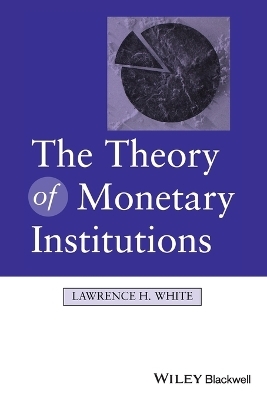
The Theory of Monetary Institutions
Wiley-Blackwell (Verlag)
978-0-631-21214-0 (ISBN)
Lawrence H. White is Professor of Economics at the University of Missouri - St. Louis. He has published articles in several journals, including the Journal of Money, Credit, and Banking; the Journal of Economic Literature; Business History Review; and American Economic Review. He is the author of Free Banking in Britain (Second Edition), and Competition and Currency. Dr. White holds an AB in Economics from Harvard University and a PhD in Economics from University of California, Los Angeles. His principal fields of study and lecture are monetary theory, banking history, the history of economic thought, and the future of money.
List of Figures and Tables. Preface.
Acknowledgments.
Part 1: The Evolution of Market Monetary Institutions:.
The Mystery of Money.
Menger's Theory Restated.
Some Implications of the Theory.
From Simple Commodity Money to Coins.
Bank-Issued Money.
Regular Par Acceptance.
Clearing Arrangements.
The Path to Fiat Money.
Spontaneous Separation Between the Media of Redemption and Account?.
Questions.
Part II: Commodity Money:.
Determining the Price Level.
The Simple Stock-Flow Analytics of Gold Supply and Demand.
The Historical Sources of Gold Supply Disturbances.
The Benefits of a Gold Standard.
The Resource Costs of a Gold Standard.
Is a Gold Standard Worth the Resource Cost?.
Questions.
Part III: Money Issue by Unrestricted Banks:.
The Purchasing Power of Money.
Bank Optimization and the Equilibrium Quantity of Bank-Issued Money.
Correcting Over-Issue by an Individual Bank.
Correcting Over-Issue by the System as a Whole.
Responding to Shifts in Demand.
Shifts Between Deposits and Currency.
Questions.
Part IV: The Evolution and Rationales of Central Banking:.
Central Banking Roles and Clearinghouse Associations.
The Origins of Government Central Banks.
Historical Cases.
Questions.
Part V: Should Government Play a Role in Money?.
Is Some Aspect of Money a Public Good?.
Are There Relevant External Benefits in the Choice of Which Money to Use?.
Are There Relevant External Benefits to the Choice of How Much Money to Hold?.
iv. Is the Supply of Base Money a Natural Monopoly?.
Questions.
Part VI: Should Government Play a Role in Banking? .
The Problem of Bank Runs.
Inherent Vulnerability in Theory: The Diamond-Dybvig Model.
The Fragility of the Diamond-Dybvig Bank: A Numerical Example.
Deposit Insurance in the Diamond-Dybvig Model.
Criticism of the Diamond-Dybvig Model.
Are Deposit Contracts Inherently Fragile?.
Historical Evidence on Inherent Vulnerability.
Is There a Natural Monopoly in Bank-Issued Money?.
Questions.
Part VII: Seigniorage:.
The Sources of Seigniorage.
Maximizing the Take from Seigniorage.
Reserve Requirements.
Other Legal Restrictions.
The Dynamics of Hyperinflation.
The Transition Between Steady States: Is Honesty a Government's Best Policy?.
How Well Does Seigniorage Explain Actual Governments' Behavior?.
Questions.
Appendix.
Part VIII: Central Bank as Bureaucracy:.
Bureaucratic Explanation of the Fed's Operating Procedures.
Bureaucracy and "inflationary bias".
Questions.
Part IX: Political Business Cycle Hypotheses:.
The Nordhaus-MacRae Model.
The Rational Expectations Critique.
An Alternative Formulation: Wagner's Political Seigniorage Cycle.
The "Partisan" Political Business Cycle Theory.
Questions.
Part X: Discretion and Dynamic Inconsistency:.
The Kydland-Prescott Model.
Positive Implications: Using the Model to Explain Changes in Inflation.
Policy Implications Under Discretion.
Rules Versus Discretion.
Subsequent Literature.
Questions.
Appendix.
Part XI: Monetary Rules:.
Benefits and Burdens of Counter-Cyclical Policy.
Independence for the Central Bank.
Arguments for Rules.
Friedman's Proposals.
McCallum's Case for a Feedback Rule.
Simple Versus Complicated Rules.
Questions.
Part XII: Competitive Supply of Fiat-Type Money:.
i. Klein's Model with Perfect Foresight.
ii. Klein's Model with "Imperfect Foresight".
Is the Equilibrium Rate of Inflation Bounded under Imperfect Foresight?.
Conclusion.
Questions.
Part XIII: Cashless Competitive Payments and Legal Restrictions:.
The Greenfield-Yeager Proposal.
Is Bundles-Worth Redemption Workable?.
Other Concerns About the GY Proposal.
The Legal Restrictions Theory.
Historical Evidence on the Non-Coexistence Prediction.
Questions.
References.
Index.
| Erscheint lt. Verlag | 12.4.1999 |
|---|---|
| Verlagsort | Hoboken |
| Sprache | englisch |
| Maße | 154 x 229 mm |
| Gewicht | 425 g |
| Themenwelt | Geisteswissenschaften |
| Sozialwissenschaften | |
| Wirtschaft ► Betriebswirtschaft / Management ► Finanzierung | |
| Betriebswirtschaft / Management ► Spezielle Betriebswirtschaftslehre ► Bankbetriebslehre | |
| Wirtschaft ► Volkswirtschaftslehre ► Finanzwissenschaft | |
| ISBN-10 | 0-631-21214-0 / 0631212140 |
| ISBN-13 | 978-0-631-21214-0 / 9780631212140 |
| Zustand | Neuware |
| Haben Sie eine Frage zum Produkt? |
aus dem Bereich


